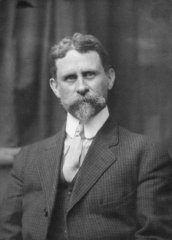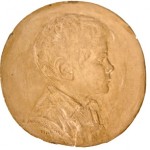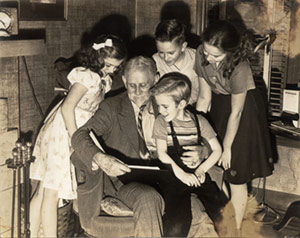Support the A. Phimister Proctor Foundation
Following in Granddad’s Footsteps

Alexander Phimister Proctor, 1893, during World’s Columbian Exposition, Chicago
The A. Phimister Proctor Museum, was established in 1997 by the artist’s grandson, Phimister Proctor Church. Though the museum has been closed, the story leading up to its creation is an amazing journey.
As a twenty-year-old college student at the University of Washington, Phimister, better known as Sandy, made it his goal to collect one of each of his grandfather’s sculptures.
This seemingly lofty goal grew into a life-long passion, evolving into a collection of thousands of pieces of original art, bronzes, plaster models, engravings, sketches, Indian artifacts, and historical documents. Sandy’s search for his grandfather’s art and life-story, led him on a journey around the United States and into several other countries, and became what he refers to as “following in Granddad’s footsteps.”
One discovery led to another, uncovering Proctor’s connection to history and the American art world. Some of the artworks Sandy discovered among Proctor’s keepsakes, were original pieces by other well-known artists who were Proctor’s friends, such as Charles Partridge Adams, Robert Vonnoh, Bessie Potter Vonnoh and George de Forest Brush.
Sandy’s daughter, Laura Proctor Ames, joined the Proctor Museum in 1998 and worked side-by-side with her father to educate the world about her great-grandfather, his life, and work. Together, Sandy and Laura share a passion for Proctor, and have had many fun adventures researching and preserving the family legacy.
In 2005, under the recommendation of several prominent art historians, the Proctor Museum donated a majority of its collection to the Buffalo Bill Historical Center (now the Buffalo Bill Center of the West), where approximately 100 original Proctor artworks are on display today.
Sandy founded The A. Phimister Proctor Foundation in 1997. Under the direction of Sandy, and now Laura as Director, the Foundation continues to discover Proctor art, to research, and to pursue educational and conservation programs.
The mission of the A. Phimister Proctor Foundation is to promote an understanding and appreciation of the art created by Alexander Phimister Proctor. Through a conscientious program of research, acquisition, publication, and exhibition, the A. Phimister Proctor Foundation strives to engage audiences in Proctor’s art and the adventurous life of the man behind it.
A note from Phimister Proctor “Sandy” Church…
 In 1944, my Granddad, Alexander Phimister Proctor, lived with our family. I remember tales he told me of cowboys and Indians, bear hunting and climbing mountains, and the old days of the Wild West. He taught me to lasso and gave me one of his old rifles. I learned about Indian culture using an Indian headdress and peace pipe, given to my Granddad by Chief Little Wolf.
In 1944, my Granddad, Alexander Phimister Proctor, lived with our family. I remember tales he told me of cowboys and Indians, bear hunting and climbing mountains, and the old days of the Wild West. He taught me to lasso and gave me one of his old rifles. I learned about Indian culture using an Indian headdress and peace pipe, given to my Granddad by Chief Little Wolf.
Before he left our house two years later, he sculpted a bas-relief of me. To this day, when I look at that piece or hold his old tools I recall the smell of clay and the hours of tedious posing… intense fidgeting was more like it! Needless to say, that 82-year-old man and his seven-year-old grandson bonded.

Alexander Phimister Proctor with his grandchildren: Sandy is on his lap. Left to right behind him: Peggy Ann, Campbell Scott, and Betty Jean.
I have always felt Granddad’s presence in my life, guiding me in my journey to share his life story and art. Now it’s my turn to give back to Granddad by promoting an understanding and appreciation of the art he created. I keep the Proctor spirit alive, by teaching others about his contributions to the world of Western art history, supporting exhibitions, researching and publishing scholarly books on his life and work.
Thanks for your interest in Proctor and for helping us share his story and the artwork he created a century ago.
— Phimister Proctor “Sandy” Church


